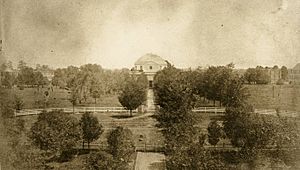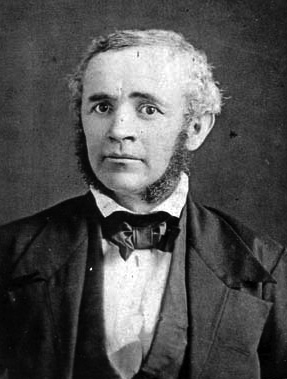Michael Tuomey facts for kids
Michael Tuomey (born September 29, 1805 – died March 30, 1857) was a very important geologist. He studied the Earth's rocks and minerals. He was the official State Geologist for South Carolina from 1844 to 1847. Later, he became the first State Geologist of Alabama in 1848, a job he held until he passed away.
Tuomey's early work was key for Alabama. He created maps and described the rich mineral resources in the Birmingham District. These resources, like iron ore and coal, were perfect for making steel. His discoveries helped Alabama become an industrial state.
Contents
Michael Tuomey: A Pioneer Geologist
Early Life and Education
Michael Tuomey was born in Cork, Ireland. His parents were Thomas and Nora Tuomey. He learned a lot at home when he was young. Michael was naturally good at observing things. He also loved natural science, which led him to study biology.
He worked as a teacher in England for a while. In the early 1830s, he moved to Somerset County, Maryland in the United States. There, he farmed and also worked as a private tutor.
Discovering Geology
In 1835, Michael went to the Rensselaer Institute in Troy, New York. This is where he found his true passion: geology. Geology is the study of the Earth, its rocks, and how it was formed. Even though he graduated that same year, geology became his life's work.
After college, Tuomey briefly worked for railroads in North Carolina. He married Sarah E. Handy from Maryland in 1837. Then, he went back to teaching and opened his own school in Petersburg, Virginia.
State Geologist in South Carolina
A famous geologist named Sir Charles Lyell recommended Michael Tuomey for a big job. In 1844, Tuomey was chosen to be the State Geologist for South Carolina. He took over from Edmund Ruffin.
He worked on South Carolina's geological survey for three years. However, he felt limited by the state's rules about his work. Sir Lyell then suggested him for a job in Alabama. Tuomey was very interested in mineralogy, which is the study of minerals. He thought Alabama would be a better place for his work. Even so, he always explained how geological surveys could help farming.
Work in Alabama
In 1847, Tuomey moved to Tuscaloosa, Alabama. He became a professor at the University of Alabama. He taught geology, mineralogy, and agricultural chemistry.
The next summer, he started his official surveys of Alabama's mineral resources. He began with Red Mountain and Jones Valley in central Alabama. These areas were rich in important minerals.
Important Discoveries and Reports
Michael Tuomey created a Geological Map of Alabama in 1849. He also published his First Biennial Report of the Geology of Alabama in 1850. In this report, he wrote something very important:
It would be difficult to find a more striking illustration of the adaptation of the earth's surface to man's wants, produced by the simplest possible means. Had the underlying rocks remained in their original horizontal positions, the whole country between the Coosa and Tombigby would have been one monotonous sandstone plain. The coal would have been completely hidden, and no one could have even conjectured the existence of the inexhaustible beds of iron ore below the surface. But the simple pushing up of the Silurian rocks has revealed all these, in the most effectual and interesting manner, at the same time that it has intersected the coal measure with valleys of great fertility.
This means he realized how the Earth's natural movements had brought valuable minerals like coal and iron ore close to the surface. This made them easy for people to find and use. He also noted that these movements created fertile valleys, which were great for farming.

Besides his official maps and reports, Tuomey wrote many articles for scientific journals. He also shared his discoveries with newspapers. He collected many mineral and fossil samples for the Alabama Museum of Natural History. Sadly, many of these were lost when the university campus was burned during the American Civil War.
In 1854, Tuomey left his teaching job to focus completely on his geological survey work. He returned to teaching in 1856 after his funding ran out. He was a member of important groups like the Boston Society of Natural History. He was also part of the American Association for the Advancement of Science.
Later Life and Legacy
Michael Tuomey's health started to fail in the spring of 1857. A doctor diagnosed him with heart disease and pneumonia. He passed away on March 30, 1857. He was survived by his wife and two daughters, Margaret and Manora.
His Second Biennial Report on the Geology of Alabama was published after his death in 1858. It was edited by John Mallett. Michael Tuomey is buried in Tuscaloosa, Alabama. The University of Alabama honored him by naming Tuomey Hall, built in 1888, after him.


